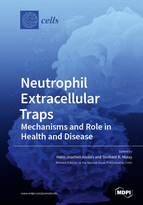Neutrophil Extracellular Traps: Mechanisms and Role in Health and Disease
A special issue of Cells (ISSN 2073-4409).
Deadline for manuscript submissions: closed (30 October 2019) | Viewed by 85224
Special Issue Editors
Interests: innate immunity; acute tissue injury; chronic tissue injjury; fibrosis; kidney disease; neutrophil extracellular traps; sterile inflammation; cell necrosis; necroinflammation; inflammasome; Toll-like receptors; regneration
Special Issues, Collections and Topics in MDPI journals
Interests: neutrophil extracellular traps; innate immunity; inflammation; regulated necrosis; acute kidney injury; chronic kidney diseases; crystallopathies
Special Issues, Collections and Topics in MDPI journals
Special Issue Information
Dear Colleagues,
Neutrophils are the most abundant leukocytes in human blood and have important roles in host defence and sterile inflammation. An absence of neutrophils or defects in neutrophil function, either inherited or acquired, is associated with immunodeficiency and autoimmunity, indicating the central role of neutrophils in health and disease. Neutrophil research has long focussed on granulopoiesis, phagocytosis, and degranulation, but since Zychlinsky et al. first reported the formation of neutrophil extracellular traps in 2004, this previously unrecognized effector function of neutrophils has attracted enormous attention in many specialist domains. Meanwhile, a role for neutrophil extracellular traps has been demonstrated in numerous disease contexts. Evolving new knowledge has been accompanied by numerous debates touching nomenclature; the significance of analytic assays; and data interpretation, a typical phenomenon in novel research domains. This Special Issue of Cells will create a forum to present and discuss new avenues in this expanding domain and will hopefully help to move the field forward towards a deeper understanding of the roles of neutrophil extracellular traps in health and disease. Therefore, we invite investigators to contribute original research, review, as well as opinion articles on this topic.
Prof. Hans-Joachim Anders
Prof. Shrikant R. Mulay
Guest Editors
Manuscript Submission Information
Manuscripts should be submitted online at www.mdpi.com by registering and logging in to this website. Once you are registered, click here to go to the submission form. Manuscripts can be submitted until the deadline. All submissions that pass pre-check are peer-reviewed. Accepted papers will be published continuously in the journal (as soon as accepted) and will be listed together on the special issue website. Research articles, review articles as well as short communications are invited. For planned papers, a title and short abstract (about 100 words) can be sent to the Editorial Office for announcement on this website.
Submitted manuscripts should not have been published previously, nor be under consideration for publication elsewhere (except conference proceedings papers). All manuscripts are thoroughly refereed through a single-blind peer-review process. A guide for authors and other relevant information for submission of manuscripts is available on the Instructions for Authors page. Cells is an international peer-reviewed open access semimonthly journal published by MDPI.
Please visit the Instructions for Authors page before submitting a manuscript. The Article Processing Charge (APC) for publication in this open access journal is 2700 CHF (Swiss Francs). Submitted papers should be well formatted and use good English. Authors may use MDPI's English editing service prior to publication or during author revisions.
Keywords
- neutrophil extracellular traps
- infection
- inflammation
- thrombosis
- autoimmunity
- gout
- sepsis
- atherosclerosis
- crystal








